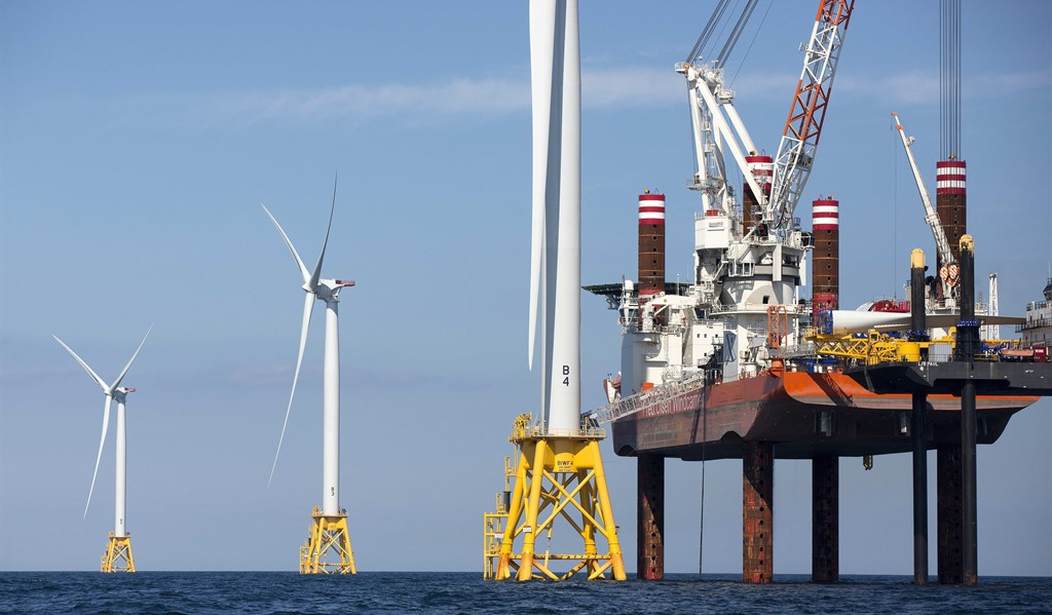You thought it had slipped my mind in all the chaos and to-do, right?
Hah! Fat chance.
Two weeks ago, Green fever dreams began washing ashore in chunks and shards on the pristine beaches of Nantucket Island after the catastrophic failure of a brand new offshore wind turbine blade.
And it was only half of the humongous, football-field-long blade that had shattered and fallen into the ocean. The rest hung forlornly off of the turbine tower like limp fettuccine, hanging on for another day or so until it dropped into the water to become a temporary navigational hazard before eventually settling on the ocean floor beneath the briny deep.
A massive section of a damaged 350-foot turbine blade from a wind farm off the coast of Nantucket that detached Thursday morning has sunk to the ocean floor, town officials said Friday.
The large piece of fiberglass “will be recovered in due course,” they said.
Within a few days, GE did quietly admit that a "manufacturing flaw" in the blade was responsible for the failure. To emphasize how big the impact is, now they have to go check about 150 other already manufactured and installed blades, you know, just in case any of those didn't have enough glue either.
A manufacturing flaw led to a turbine blade failure at the Vineyard Wind offshore project off the coast of Massachusetts this month, the part's producer, GE Vernova (GEV.N), opens new tab, said on Wednesday.The turbine blade broke on July 13 and left potentially dangerous debris on beaches on the island of Nantucket. U.S. authorities later ordered a shutdown of the project, which is still under construction.GE Vernova said a preliminary analysis had determined that insufficient bonding led to the breakage, adding its quality assurance program should have identified the issue.
Yeah, 'coulda, shoulda' always bites you in the asterisk.
...The company said it would re-inspect all its offshore wind blades to check for potential defects. The company has made about 150 blades at its Gaspe, Canada facility.
...The incident is a blow to Vineyard Wind, the first major U.S. offshore wind farm, and the nation's budding offshore wind industry. The sector is regarded as critical to meeting U.S. President Joe Biden's climate change goals, but has been struggling with soaring costs and delays.
...It was not clear how the revelation of the manufacturing misstep would impact Vineyard Wind's construction timeline. In a regulatory filing, GE Vernova said it had installed 24 of the project's expected 62 turbines. Additional turbine parts are awaiting installation at a port staging area in New Bedford, Massachusetts.
In any event, there's not much going on at the project, as the Bureau of Safety and Environmental Enforcement just reissued its original incident related suspension order.
The Bureau of Safety and Environmental Enforcement today issued a new Suspension Order to Vineyard Wind 1 clarifying operational requirements and listing actions the company must take prior to personnel boarding any wind turbines.
The order comes as the bureau continues its oversight and investigation into the July 13, 2024, turbine generator blade failure. The order continues to prohibit Vineyard Wind 1 from generating electricity from any of the facilities or building any additional wind turbine generator towers, nacelles, or blades. This order also requires Vineyard Wind 1 to submit to BSEE an analysis of the risk to personnel and mitigation measures developed prior to personnel boarding any facility...
The originally ballyhooed GE Vernova blades are now garnering mixed reviews and some are finally questioning if they were "ready for prime time."
When Vineyard Wind completed the installation of the first GE Vernova Haliade-X 13-megawatt wind turbine in the waters southwest of Nantucket in October 2023, the company trumpeted it as “the largest turbine in the western world.” It was supposed to be one of the 62 turbines that would make up the first large-scale, commercial offshore wind farm in the United States.
...While offshore wind energy production has a decades-long track record in Europe and Asia, the Vineyard Wind project was the first of its kind in the United States, and the turbines Vineyard Wind is installing are larger and more powerful than any that have come before it.
The technology may not be new, but the size and scale of the Haliade-X turbine is novel for the offshore wind industry. And these jumbo-sized turbines have only recently been installed in just two locations in the world within the last year - at Vineyard Wind off Nantucket, and the Dogger Bank Wind Farm off the northeast coast of England. The Haliade-X turbine blades - which are supposed to have at least a 25-year lifespan - have suffered failures in both locations.
And maybe don't build something that big until you can actually "test" it?
...But the MassCEC facility, which had been constructed in 2011, wasn’t built for blades the size of the ones GE wanted to mount on the Haliade-X turbine. So the testing center “had to cut part of the blade off to fit it in the building,” according to a May 2022 report by CommonWealth Beacon. “While blades can be tested without the tip, it is not ideal, and engineers need to account for the adjusted weight.” Offshore wind technology, according to Massachusetts Clean Energy Center CEO Jennifer Daloisio, had advanced faster than expected. Even so, the jumbo turbine model was selected for a number of offshore wind projects around the world. In December of 2020, Vineyard Wind announced that it had selected GE’s Haliade-X turbine for the project off Nantucket.
What a cluster before the first tower even went in the water.
So, with construction at Vineyard Wind halted, one would imagine the wind farm company partners and GE had been all over this disaster trying to square things away, right?
Well, you'd think so, but then again, you're dealing with renewable grifters. They don't seem in too big of a hurry to do jack. Locals are already pissed off.
“You’re kind of good at saying nothing in a whole lot of words,” one local woman said to @VineyardWindUS CEO Klaus Moeller.
— NE Fishermen's Stewardship Assoc. (@fishstewardship) July 30, 2024
It's time proponents of offshore wind are held accountable for their disastrous decisions.https://t.co/WLB3ZbM1Mu
On Monday, they informed the town of Nantucket that, "Oh, by the way, some more blade remnants fell 'into the water column' and some are laying on the tower base. Watch out for floating stuff."
Now wait a minute, here.
According to GE Vernova, the detachment was not unexpected, though it has been
— Nantucket Current (@ACKCurrent) July 29, 2024
several days since any debris detachment was last observed. The U.S. Coast Guard
continues to enforce a 500-meter safety exclusion zone around the turbine. pic.twitter.com/zAUrEKVuVw
The Coast Guard is shooing people away from the tower, the company expected bits to keep falling off, but they've done nothing so far to remove any of it that is smoked? So why haven't they at least set up a collar or something to keep floaty bits corralled near the tower instead of allowing flotsam to float off to despoil beaches and choke wildlife? Maritime companies use floating collars to contain oil spills and debris flows all the time.
Am I missing something?
GE did let the town know they'd completed some procedure that would allow them to begin to remove the blade.
...Additionally, GE reports that the rotor movement exercise, which resulted in the controlled release of a one-meter piece of debris, has been completed. This exercise was a crucial step towards developing a comprehensive plan for the full blade removal, with a primary focus on safety.
Oh yay.
But if I were the formerly thrilled-about-Vineyard-Wind residents, I'd be knee-deep in a very interesting lawsuit filed at the end of June by the Public Service Company of Oklahoma and Southwestern Electric Power Company (AEP) against GE before I ever, EVER let another boat toodle out to that project with a turbine blade. Especially a GE blade made where this failed one originated.
...At Vineyard Wind, the turbine blade failure is being blamed on a “manufacturing deviation” that occurred at the LM Wind Power factory in Gaspé, Canada, one of two locations where the Haliade-X blades are manufactured. LM Wind Power was acquired by GE Vernova for $1.65 billion in 2017.
The Oklahoma lawsuit has some disturbing parallels, and the introduction is a strongly worded accusation.
l. This is an action for breach of contract and breach of warranty arising from the purchase and sale of hundreds of wind turbine generators supplied by GE for three individual wind power generation projects located in Oklahoma. Within only two to three years of commercial operation, the GE wind turbine generators have exhibited numerous material defects on major components and experienced several complete failures, at least one turbine blade liberation event, and other deficiencies.
2. As of the date of this Complaint, a significant portion of the wind turbine generators have completely failed or have otherwise been rendered inoperable, requiring immediate repair. An even larger portion have exhibited one or more material defects that are reasonably expected to result in failures within their useful service life that will require expensive repairs. AEP has already incurred millions of dollars in costs and damages as a result of the wind turbine generator failures and/or defects.
3. AEP expects to incur millions of dollars in costs and damages in the future because AEP will inevitably need to repair and/or replace additional wind turbine generators in order to meet the energy production requirements of its customers, and GE has refused to acknowledge its responsibility to repair and/or replace all defective wind turbine generators. Therefore, in addition to its claims for money damages, AEP seeks a declaratory judgment that GE is liable for expected future failures of GE’s wind turbine generators.
But it's in the particulars of the lawsuit that the "uh-oh" moment should come. Remember that Canadian blade factory?
Oh. Hello.
...34. There were also defects and failures identified in the wind turbine generators for all three projects affecting components other than the main bearings. Additional defects include, but are not limited to, the following:
...e) LM Blade Root Delamination. The LM blades are connected to the pitch bearings and drive the operation of the wind turbine generators. All wind turbine generators that utilize the LM blades at all projects are subject to delamination at the blade root. If not detected and remedied, the delamination can progress and cause blade failures that could result in blade liberation.
LM blades delaminating is not news. According to this lawsuit and previous complaints from the Oklahoma projects, GE knew there was a problem with the root lamination of blades being manufactured at the LM factory in Canada. And this Vernova blade off Nantucket didn't even survive the start of testing before blowing apart.
As many are asking, what happens in a stiff Nor'easter or a hurricane if it can't handle spinning on a good day?
In Oklahoma, when blades fail, they make a mess on the ground around them. When the shattered remnants of 26-ton, 300+-foot blades fail in the ocean, they are shared for hundreds of miles and with millions of living things in and out of the water. There will be 186 massive blades on this project alone if allowed it to proceed. There are more plans that will bring the turbine numbers offshore of New England to the thousands. Multiply that times 3 for the blades.
Is Massachusetts - are any of the states - still willing to take that chance after this warning shot?
And for what gain at what price? There's the question that the renewable industry cannot answer.
The MA governor is at long last receiving some scrutiny over her connections to the Green Grift.
Not only that, our electric bills are higher than any other state. I know mine is up 50% and no I don't have air conditioning. That's because of the law that went into effect this year that says some 60% of power generation must come from solar and wind. Have you ever seen a…
— Kenneth 老百姓 Rapoza (@BRICbreaker) July 31, 2024
And in their typical tone-deaf fashion, Second Dude Doug Emhoff was on Nantucket yesterday ginning up cash with the rich folk for his climate cult fascist candidate wife.
...“I hope while he’s here he takes a look around, talks to people, and maybe brings back the message that we should at the very least shut them down until we get some real answers,” Nantucket resident Amy DiSibio said of Emhoff’s visit in an interview with the Herald.
DiSibio was referring to the island’s desire for the feds to completely shut down the Vineyard Wind project, which has left Nantucket a debris mess since the blade failure sparked on July 13.
Local lobstahman ain't havin' none of him.
Second Gentleman Doug Emhoff, the husband of Vice President Kamala Harris, just arrived on Nantucket for a fundraiser.
— Nantucket Current (@ACKCurrent) July 30, 2024
Island lobsterman Dan Pronk was waiting to greet him near the airport with a piece of Vineyard Wind debris. pic.twitter.com/U4LvTnyCdT
In the meantime, there's more Green inbound.
Just spoke with @ackharbormaster and she said Nantucket should expect more Vineyard Wind debris to wash up from the latest blade detachment.
— Nantucket Current (@ACKCurrent) July 30, 2024
This photo from last Sunday off Muskeget island west of Nantucket: pic.twitter.com/TgtkxzSn9s
It remains to be seen what will happen from here, but, for starters, I'd sure be digging into that lawsuit. I'd know it chapter and verse.
At the very least.







Join the conversation as a VIP Member